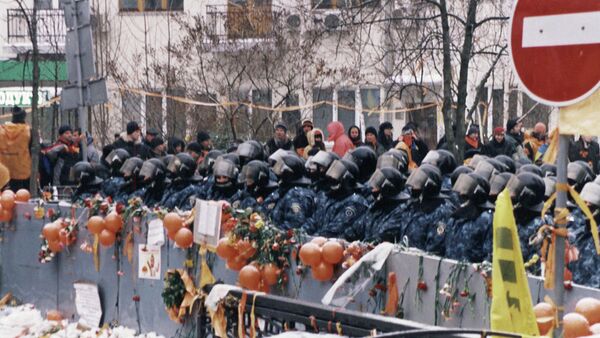Color Revolutions are two completely different things depending on one’s perspective. They can either be friendly pro-democracy movements against evil dictatorships or wretched and illegal mob violence threatening stability and order. Westerners tend to have an overall positive view of these events, whereas others are more suspicious, if not outright opposed to them. Let’s look at each one in brief.
The Prototype:
2000 – Serbia’s “Bulldozer Revolution”
Protesters overthrew President Slobodan Milosevic after alleging that he rigged the election, with a pro-Western government soon replacing him. The revolution itself was short, but the networking techniques utilized in it would be far-reaching and serve as a template for future Color Revolutions.
The Color Revolutions:
2003 – Georgia’s “Rose Revolution”
As in Serbia, protesters alleged that then-president Eduard Shevardnadze manipulated an election to his favor and therefore had to be overthrown. It was also very short and led to the vehemently pro-Western politician Mikhail Saakashvili assuming power.
2004 – Ukraine’s “Orange Revolution”
Following the established pattern, protesters called for a revolution after Viktor Yanukovich was accused of defrauding the presidential vote. They deposed him in a largely non-violent coup, and he was later replaced with Viktor Yushchenko and his sidekick Yulia Tymoshenko, both extreme Western sympathizers.
2005 – Kyrgyzstan’s “Tulip Revolution”
People took to the streets to protest after President Askar Akayev was accused of manipulating a recent parliamentary vote. This revolution was marked by mild violence that eventually led to the pro-Western government of Kurmanbek Bakiev.
Color Revolutions 2.0:
Those were the official Color Revolutions as recognized by the West, but Russian observers characterize a few other government overthrows as following the same pattern:
2010 – Kyrgyz Revolution:
Disgusted at the rampant corruption of President Bakiev, the Kyrgyz people overthrew him in a violent movement that saw shades of ethnic tension against the Uzbek minority. The new government reaffirmed its commitment to the contentious US transit facility at Manas (which some had discussed closing), but also pragmatically improved relations with Russia.
2011 – ‘Arab Spring’ Events:
All of these popularly known destabilizations were actually Color Revolutions, said Russia’s Chief of the General Staff Valery Gerasimov during a conference last May, and they represent a new form of adaptive warfare by the US.
2013 Ukraine’s “EuroMaidan”:
Enraged by President Yanukovich’s decision to delay signing the EU Association Agreement, people from all over Ukraine traveled to Kiev to demand the government’s resignation and a pro-European political course. Violent and extreme right-wing elements soon took charge of the movement and eventually overthrew the government a day after signing a supposed agreement to halt hostilities. Shortly thereafter, Kiev began a civil war against the Eastern Ukrainians who refused to accept the coup-imposed government’s authority.
The Common Denominators
On the surface, all of these events might look dissimilar and unrelated, but they really have a lot of integral things in common. Let’s take a look:
Ideology:
Many of the regime-change ringleaders calling for coups in the abovementioned areas followed the tactics of Gene Sharp, best known for his works “From Dictatorship to Democracy” and “The Politics of Nonviolent Action”. Despite inspiring thousands of them in the afflicted areas, Sharp refuses to take credit for their efforts. He was also the subject of the award-winning British documentary “How to Start a Revolution”.
Organization:
All actual and suspected Color Revolutions had some type of pro-Western element within them, some more so than others. Also, Western government-affiliated NGOs such as the National Endowment for Democracy and Open Society Foundation have been linked to some of the movements and their funding. In terms of on-the-ground organization, many of the masses do not realize the geostrategic ramifications of their anti-government actions (whether honest or misguided), since they’re coordinated by a small core of activist.
The Event:
All Color Revolutions have some type of event that supposedly inspires their advocates to take to the streets. This can be an election, a controversial piece of legislation, regional destabilization (as was the case with the ‘Arab Spring’), or whatever else could be marketed as galvanizing the gullible. The idea here is to pick an event of relative significance that can attract the attention of the Western media.
Foreign Media Pressure:
The Western media sooner or later always levels pressure against the governments defending against a Color Revolution. It doesn’t matter whether it was Muammar Gaddafi or Slobodan Milosevic, once the media paints a leader as being a ‘dictator suppressing democracy’, all coverage turns against them.
The Bigger Picture:
Playing the cynic, one could say that each Color Revolution benefited the US in its own way. For example, the ones in the former Soviet republics helped create a cordon of anti-Russian pro-Western governments around Russia, while the ‘Arab Spring’ events could be seen as America’s intent to guide the inevitable leadership transitions in the region (Egypt, Tunisia) and also eliminate non-compliant governments like Gaddafi or Assad’s.
So you decide – are Color Revolutions really as spontaneous, innocuous, and indigenous as they’re made to seem, or could they really be a new form of indirect warfare against geostrategic states and resistant leaders?

